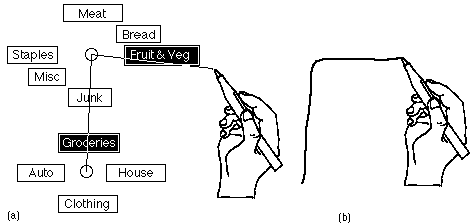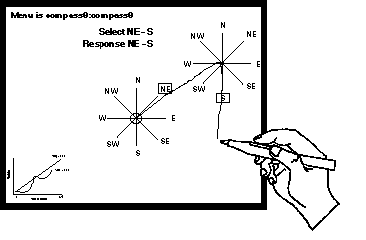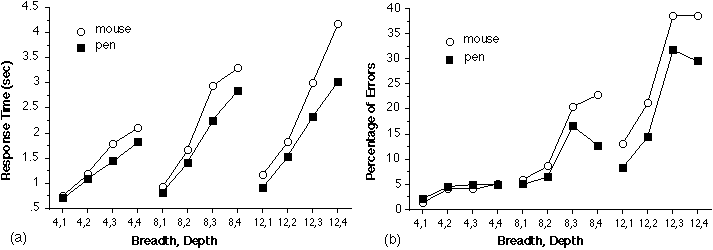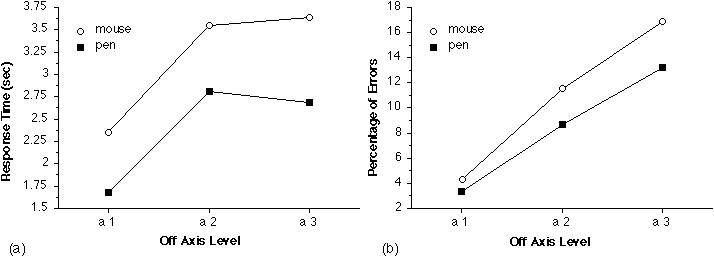
The Limits Of Expert Performance Using Hierarchic Marking Menus
Gordon Kurtenbach and William Buxton
Dept. of Computer Science
University of Toronto
Toronto, Ontario Canada, M5S 1A1
Phone: (416) 978-6619, Email: gordo@dgp.toronto.edu, willy@dgp.toronto.edu
ABSTRACT
A marking menu allows a user to perform a menu selection by either popping-up a radial (or pie) menu, or by making a straight mark in the direction of the desired menu item without popping-up the menu. A hierarchic marking menu uses hierarchic radial menus and "zig-zag" marks to select from the hierarchy. This paper experimentally investigates the bounds on how many items can be in each level, and how deep the hierarchy can be, before using a marking to select an item becomes too slow or prone to errors.KEYWORDS: Marking menus, pie menus, gestures, pen based input, accelerators, input devices
This story reveals the philosophy behind an interaction technique we call "marking menus". Marking menus are a type of pop-up menu where, if the user can recall the location of the item in the menu, the item can be selected without having to pop-up the menu. Just like in the story, it's nice not having to wait for Lloyd to bring a menu when you know what you want and how to order it.
Menus are used extensively in human computer interfaces. They provide critical information on what commands are available and a way to invoke commands. Unfortunately, many computer menus do not provide the kind of service that the restaurant in our example does. One cannot order without having to look at the menu and this can be a problem. Some menus require substantial computing before display and this delays the user. Also, menus appearing and disappearing on the screen can be visually disruptive. Finally, a menu may obscure objects on the screen that are the focus of attention.
Some systems do provide methods to by-pass menus but the by-pass mechanism requires an action that is radically different than selecting using the menu. For example, in some systems, a user selects from a menu using the mouse but by-passes the menu using an "accelerator key" on the keyboard. Using our restaurant example again, this would be like changing from ordering verbally, when one has the menu, to ordering with hand signals when one doesn't have the menu. The problem is that one has to learn two different protocols.
Marking menus are designed to overcome this problem. Using a marking menu with a pen based computer works as follows. A novice user presses down on the screen with the pen and waits for a short interval of time (approximately 1/3 second). A radial menu [13] [4] then appears directly under the tip of the pen. A user then highlights an item by keeping the pen pressed and making a stroke towards the desired item. If the item has no sub-menu, the item can be selected by lifting the pen. If the item does have a sub-menu, it is displayed. The user then continues, selecting from the newly displayed sub-menu. Figure 1 (a) shows an example. Lifting the pen will cause the current series of highlighted items to be selected. The menus are then removed from the screen. At any time a user can indicate "no selection" by moving the pen back to the center of the menu before lifting, or change the selection by moving the pen to highlight another item before lifting. Finally a user can "back-up" to a previous menu by pointing to its center.
The other, faster, way to make a selection without popping up the menu is by drawing a mark. A mark can be drawn by pressing the pen down and immediately moving. The shape of the mark dictates the particular series of items selected from the menu hierarchy. Figure 1 (b) shows an example.
The first important point to note is that the physical movement involved in selecting an item from the menu is identical to the physical movement required to make the mark corresponding to that item. With marking menus, a user actually rehearses the physical movement involved in making the mark every time a selection from the menu is made. We believe that this helps users learn the markings. The second point to note is that supporting radial menus with markings in this way helps users make an efficient transition from novice to expert. Novices perform menu selection because they are not familiar with the menu and its layout. As they become experts, they begin to use the markings instead. Novices, in effect, "learn on the job" because these two activities are so similar.
Is marking much faster than using the menu? In a study of user behavior with non-hierarchic marking menus in a real application, we found that using a mark was approximately 3.5 times faster than using the menu, even if the 1/3 of second delay to pop-up the menu was subtracted from menu selection time (for example, one user required on average 0.2 seconds to select using a mark and 0.7 seconds to select using the menu) [8]. Displaying the menu actually takes a small amount of time (0.15 seconds in our system). The larger amount of time is consumed waiting for the user to react to the display of the menu, even if the location of the desired menu item is known. While these time savings may seem trivial, one user performed approximately 15,000 selections over 36 hours of work. Using marks helped her complete the task 1.25 hours sooner.

Figure 1. Hierarchic marking menus can be selected from using two different methods. Using method (a), radial menus can be sequentially displayed and selections made. Method (b) uses a marking to make the same selection. Method (a) is good when the user is unfamiliar with the menu. Method (b) is good when the user is familiar with the menu and wants to avoid waiting for the display of each menu.
We performed an experiment to address questions one asks when designing
an interface that will use hierarchic marking menus.
Q1: Are hierarchic marking menus a feasible idea? Non-hierarchic marking menus have proven to be feasible [9]. Other research has shown that radial menus are faster than linear menus [1]. Thus we can expect marking menus, even without using the faster marking ahead technique, to be faster that traditional linear menus. Nevertheless, the question remains as to whether it is possible to use a marking to select hierarchic menu items.
Q2: How deep can one go using a marking? Just how "expert" could users become? Could an experienced user use a mark to select from a menu which had 3 levels of hierarchy and twelve items at each level? By discovering the limitations of the technique we would be able to predict what menu configurations, with enough practice, will lead to reliable selection using a marking, and which menu configurations, regardless of the amount of practice, will never permit reliable selection using a marking. Also, will some items be easier to select regardless of depth? For example, it seems easier to select items that are on the up, down, left and right axes even if the menus are cluttered and deep.
Q3: Is breadth better than depth? Will wide and shallow menu structures be easier to access with markings than thin and deep ones? Traditional menu designs have breadth/depth trade-offs [5]. What sort of trade off exists for marking menus?
Q4: Will mixing menu breadths result in poorer performance? A previous experiment on non-hierarchic marking menus has shown that the number of items in a menu and the layout of those items in the menu affects selection performance when markings are used [9]. Specifically, menus with 2, 4, 6, 8 and 12 items work quite well for markings. What will be the effect of selecting from menu configurations where the number of items in a menu varies from sub-menu to sub-menu?
Q5: Will the pen be more suitable than the mouse for making marks? The experiment mentioned above also compared making selections from non-hierarchic marking menus using a tablet with a stylus, a trackball and a mouse. The trackball was the worst performer, while the tablet with stylus and mouse performed equally. However, hierarchic marking menus require more complex marks. Will the mouse prove inadequate?

Figure 2: The experiment screen at the end of a trial where the target was "NE-S". After the marking was completed, the system displayed the menus along the marking to indicate to the subject the accuracy of their marking.
Will users of real applications ever be as familiar with menus as
they are with a clock or compass? We believe the answer is yes and base
this on three pieces of evidence. First, our own behavioral study of users
using a marking menu in a real application shows, with practice, markings
are used over ninety percent of the time [8]. Other
researchers have reported this type of familiarity with pie menus [4].
Second, research has shown that the effects of menu organization disappear
with practice [2][10]. In other
words, with practice, users memorize menu layouts and navigate directly
to the desired menu item. Finally, it must be remembered that a user does
not have to memorize the layout of an entire menu. For example, a hierarchic
marking menu could contain 64 items but the user might only memorize the
markings needed to select the two most frequently used menu items.
The general design of a trial in our experiment was as follows. The system would ask the subject to select a certain item using a marking (the menu could not be popped up by the subject). The subject would draw the marking and the system would then record the time taken, and whether or not a successful selection was made. We would then vary the menu configuration and input device and see what effect these variables had on selection performance.
Equipment: A Momenta pen based computer was used. The input devices consisted of a Microsoft mouse for IBM personal computers, and a Momenta pen and digitizer.
Task: A trial occurred as follows. The type of menu configuration currently being tested would appear in the top left corner of the screen. A small circle would appear in the center of the screen. A subject would then press and hold the pen or mouse button over the circle. The system would then display instructions describing the target at the top center of the screen. A subject would then respond by drawing a mark that was hoped to be the correct response. The system would respond by displaying the selection produced by the marking. If the selection did not match the target, the system would beep to indicate an error. The system would then display each menu in the current menu configuration at its appropriate location along the marking and indicate the selection from each menu. A subject's score would then be shown in the lower left of the screen. Figure 2 shows the experimental screen at this point. If a selection was incorrect, a subject would lose 100 points and the trial would be recorded as an error. If a selection was correct, the subject would earn points based on how quickly the response was executed. Response time was defined as the time that elapsed between the display of the target and the completion of the marking.
Design: All three factors, device, breadth and depth were within-subject. Trials were blocked by input device with every subject using both the pen and the mouse. One half of the subjects began with the pen first while the other half began with the mouse. For each device, a subject was tested on the 13 menu configurations (breadths 4, 8 and 12 crossed with depths 1 to 4, plus the mixed menu configuration of clock:compass8:clock). Menu configurations were presented in random order. For each menu configuration, a subject performed 24 trials. During the 24 trials, subjects were repeatedly asked to select 1 of 3 different targets. Each target appeared eight times in the 24 trials but the order of appearance was random.
Before starting a block of trials for a particular menu configuration, subjects were allowed 8 seconds to study the menu configuration. Before starting trials with a particular input device, a subject was given ten practice trials using the device on a compass4:compass4:compass4 menu.
Subjects responded significantly faster with the pen than with the mouse (F(1,11)=19.7, p < .001). The response time averaged across all subjects, breadths and depths for the pen was 1.69 seconds while the mouse averaged 2.07 seconds. As menu breadth and depth increased subjects' performance with the two devices began to differ. This is shown in figure 3.
Subjects produced significantly more errors with the mouse than with the pen (F(1,11)=6.41, p < .05). Both depth and breadth interacted to affect error rate (F(6,66)=12.28, p < .001). Figure 3 (b) shows that mouse and pen error percentages began to differ once menu breadth reached eight items. For either device, error rates were below 10% for up to menus of breadth 8 and depth 2.

Figure 3: Response time and percentage of errors as a function of menu breadth, depth and input device. Each data point is the average of 288 trials.
We tested for effects of mixing menu breadths in menu configurations
by comparing the performance of a clock:clock:clock menu with a clock:compass8:clock
menu. We found no significant performance differences between the two menu
configurations.
In order to test the hypothesis that markings which consist of "on axis"
items (items on the vertical and horizontal axes) out-perform "off axis"
markings, we picked targets for menus of breadth twelve, depths two, three
and four such that the experimental data could be divided into 3 groups.
With each group we associated an "off axis-level": a1, a2 and a3. Experimental
data was placed in group a1 if the target consisted strictly of menu items
that were on-axis, such as "12-3-9-3". Group a3 consisted of data on targets
that consisted of entirely off-axis targets such as "1-2-1-2". Group a2
consisted of data on targets that were a mixture of on-axis and off-axis
menu items, such as "12-7-3-9". Figure 4 shows that axis level had a significant
effect on response time (F(2,22)= 104.84, p < .001) and on percentage
of errors (F(2,22)=36.2, p < .001). Figure 4 (a) shows how the type
of device interacted with off-axis level (F(2,22)=6.93, p < .05). This
indicates that subjects' response time on the worse off-axis targets did
not degrade as badly with the pen as it did with the mouse.
Q1: Are hierarchic marking menus a feasible idea? Even if using a marking to access an item is too hard to draw or cannot be remembered, a user can perform a selection by displaying the menus. Nevertheless, since the subjects could perform the experiment, it is feasible that markings could be used to select hierarchic menu items.
Q2: How deep can one go using a marking? Our data indicates that increasing depth increases response time linearly. The limiting factor appears to be error rate. For menus of four items, even up to four levels deep, the error rate was less than ten percent. This is also true for menus of eight items, up to a depth of two. However, when using markings for menus with eight items or more, at depths greater than two, selection becomes error-prone, even for the expert. However, our "off-axis" analysis indicates that the source of poor performance at higher breadths and depths is due to selecting "off-axis" items. Thus, when designing a wide and deep menu, the frequently used items could be placed at "on-axis" locations. This would allow some items to be accessed quickly and reliably with markings, despite the breadth and depth of the menu.

Figure 4: Average response time and percentage of errors for targets with an increasing number of "off-axis" items.
What is an acceptable error rate? The answer to this question depends
on the consequences of an error, the cost of undoing an error or redoing
the command, and the attitude of the user. For example, we have data that
indicates, in certain situations, experts produce more errors than novices
[11]. The experts were skilled at error recovery and
thus elected to trade accuracy for fast task performance. Our experiences
with marking menus with six items being used in a real application indicates
that experts perceived selection to be error-free. Other research reports
that menus with up to eight items produce acceptable performance [4].
Marking menus present a classic time versus accuracy trade-off. If the
marking error rate is too high, a user can always use the slower but more
accurate method of popping up the menus to make a selection.
Q3: Is breadth better than depth? For menu configurations that resulted in acceptable performance, breadth and depth seems to be an even trade-off in terms of response time and errors. For example, accessing 64 items using menus of four items, three deep, is approximately as fast as using menus of eight items, two deep, and both have approximately equivalent error rates. Thus, within this range of menu configurations, a designer can let the semantics of menu items dictate whether menus should be narrow and deep, or wide and shallow.
Q4: Will mixing menu breadths result in poorer performance? The experiment did not show this to be true. This may be due to the fact that our menu labels strongly suggested the correct angle to draw at, and therefore confusion was avoided. A stronger test might be to compare mixing menu breadths using less suggestive labels. However, our results do indicate that, with enough familiarity with the menus, mixing breadths is not a significant problem.
Q5: Will the pen be better than the mouse for making marks? Overall,
subjects performed better with the pen than with the mouse. However, for
small menu breadths and depths, subjects' performance, with either the
mouse or pen, was approximately equivalent. We found this extremely encouraging
because it implies that a marking menu is an interaction technique that
not only takes advantage of the pen but also remains compatible with the
mouse.
We are continuing to gather both programmer and user feedback on using markings menus in many applications [6].
A marking menu is a specific instance of an interaction technique that
supports both the novice and expert user, and trains a novice to become
expert. We are investigating how this philosophy can be applied to other
types of interaction techniques and markings.
2. Card S. K. (1982) User perceptual mechanisms in the search of computer command menus. Proceedings of Human Factors in Computer Systems. SIGCHI, 190-196
3. Elrod, S., Bruce, R., Gold, R., Goldberg, D., Halasz, F., Janssen, W., Lee, D., McCall, K., Pedersen, E., Pier, K., Tang, J. & Welch, B. (1992) Liveboard: A large interactive display supporting group meetings, presentations and remote collaboration. Proceedings of CHI `92, 599-607
4. Hopkins, D. (1991) The Design and Implementation of Pie Menus. Dr. Dobb's Journal, December, 1991, 16-26
5. Kiger, J.L. (1984) The depth/breadth trade-off in the design of menu-driven user interfaces. International Journal of Man Machine Studies, 20, 210-213
6. Kurtenbach, G. & Baudel, T. (1992) HyperMark: Issuing commands by drawing marks in Hypercard, Proceedings of CHI '92 poster and short talks, 64
7. Kurtenbach, G. & Buxton W. (1991) Issues in combining marking and direct manipulation techniques. Proceedings of UIST '91, New York: ACM, 137-144
8. Kurtenbach, G. (1992) The evaluation of an interaction technique based on self-revelation, guidance and rehearsal. (in preparation) Ph.D. thesis, University of Toronto
9. Kurtenbach, G., Sellen, A. & Buxton, W. (1993) An empirical evaluation of some articulatory and cognitive aspects of "marking menus". Journal of Human Computer Interaction , Volume 8, Number 1
10. McDonald, J. E., Stone, J. D. & Liebelt, L. S. (1983) Searching for items in menus: The effects of organization and type of target. Proceedings of Human Factors Society 27th Annual Meeting. Human Factor Society, 834-837
11. Sellen, A.J., Kurtenbach, G. & Buxton, W. (1992) The prevention of mode errors through sensory feedback. Journal of Human-Computer Interaction. Vol. 7(2), 141-164
12. Weiser, M. (1991) The computer for the 21st century. Scientific American, September 1991, volume 265, 3, 94-104
13. Wiseman, N.E., Lemke, H.U. & Hiles, J.O. (1969) PIXIE: A New Approach to Graphical Man-machine Communication, Proceedings of 1969 CAD Conference Southhampton, IEEE Conference Publication 51, 463